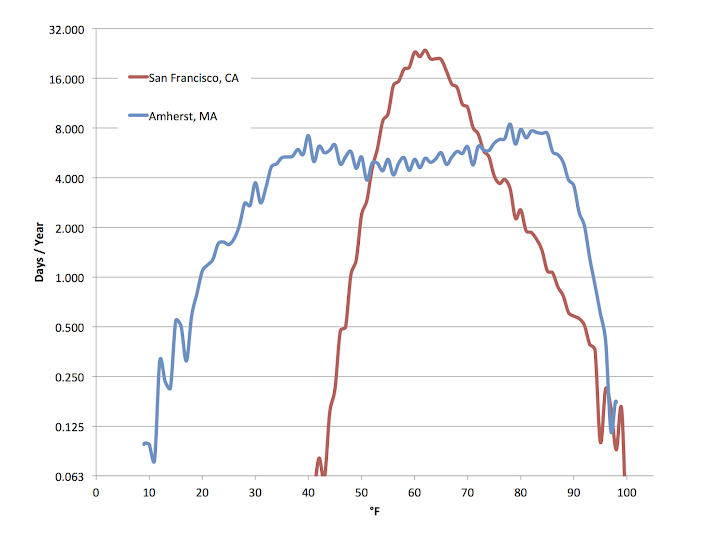I made a long post with graphs of daily maximum distributions on the Death Valley thread; I thought perhaps they deserved their own thread. First, using 1961-2012 station data for
Amherst, MA and
San Francisco, CA. The San Francisco data is from the Mission District, which is relatively warm for the city, further away from the Pacific and the worst of the fog blocked by low hills. The graph below shows the number of days/year with a particular temperature in °F. I chose °F because the US Weather Service records temperature to the nearest °F.

Interesting observations:
1) San Francisco has a single peak around the low 60s, with a steep decline with colder or warmer temperatures.
2) In San Francisco, for temperatures far away from the mean, the hot temperatures have a much longer tail while colder maxes become rare very quickly for colder °F. Probably because there's a distant but rare source of hot weather (inland) but no real path for very cold weather to arrive, the sea buffers cold temperatures more. The interior is not that much colder than city in the winter, but much hotter in the summer.
3) Amherst has two peaks: a summer peak around 80°F, and a winter peak around 40°F (colder than any day in the San Francisco record!).
4) Opposite of San Francisco, the cold extremes of Amherst have a longer tail while the hot extremes become very rare with a smaller increase in temperatures. For that reason, the summer peak is taller on the graph with more days: days tend to cluster more at the peak while the winter distribution in temperature is broader. In the warmer months, a dry sunny day (and many non-sunny ones mid-summer) will hover rather close to 80°F. In winter, the temperature of a clear day is unpredictable.
5) Amherst has a trough for mild maxes (50s and 60s). If you love those temperatures, you'll get frustrated, as many days tend to be warmer or colder. You can be consoled that they're at least more common than 20s or 90s. This makes sense because there's fewer months that average around that temperature.
I can make more of these graphs rather quickly for many US stations (and maybe some non-US stations).
To see the shape of the extremes, a log scale is helpful. Here's the same on a log scale.

For both cities, you can see the slope of the line stays mostly the same at more extreme temperatures. Amherst seems to deviate from a line more, perhaps a quadratic would be a better fit (a line on a log scale is an exponential decay; a quadratic polynomial, a Gaussian). The data is sparse enough at the extremes it's difficult to judge the best fit. For the coldest temperatures, the distribution of temperatures of Amherst definitely does not follow a quadratic fit. In the record there, is one temperature at -3°F, four at 6°F, one at 8°F, and five each at 9°F and 10°F, it doesn't follow any clear decay pattern.
For the hottest temperatures, the decrease in frequency of hotter temperatures fits a curve better. Here are two cumulative graphs I made. They graph the number of days above a specific temperature:

And on a log scale to better compare the rarer temperatures:

San Francisco has a fairly steady slope, while for Amherst, warm temperatures are rather common and then with slightly more heat, their frequency drops rapidly off. Unlike at the cold end, you don't get random extreme outliers not following the smooth curve. Now, I also looked at numbers for
Death Valley, CA. Because Death Valley is so much hotter, I can't fit on the same temperature axis. Instead is set all of them relative to the hottest recorded temperature. On this scale, -1°F is one degree cooler than the hottest ever recorded so 98°F for Amherst, 102°F for San Francisco, 128°F Death Valley. -5°F on this scale would be 5°F cooler than the record.

What I find really neat here, is that even though Amherst and Death Valley have completely different weather, the distribution of extremely hot temperatures (relative to the record) is similar. Now I find a frequency (non-cumulative) graph of the hottest temperatures recorded at Death Valley.

Log scale again, to see the extreme events better. I fit a quadratic to the graph, shown as a dashed line. Extrapolating it predicts the frequency of increasingly hot temperatures, but it's hard to gauge it's accuracy, as it's just statistic fitting onto sparse data with no science behind it. I added some comments on the prediction at the end of
this post, which has some of the same graphs.


 Please register to participate in our discussions with 2 million other members - it's free and quick! Some forums can only be seen by registered members. After you create your account, you'll be able to customize options and access all our 15,000 new posts/day with fewer ads.
Please register to participate in our discussions with 2 million other members - it's free and quick! Some forums can only be seen by registered members. After you create your account, you'll be able to customize options and access all our 15,000 new posts/day with fewer ads.